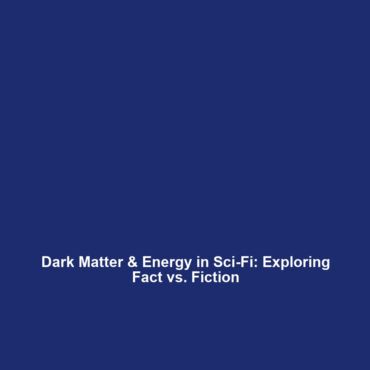Dark Matter & Dark Energy in Popular Science Fiction: Fact vs. Fiction
Introduction
Dark matter and dark energy are enigmatic phenomena that constitute a significant portion of the universe. In popular science fiction, these concepts often serve as intriguing plot devices, but they also raise important questions about the nature of reality. This article delves into Dark Matter & Dark Energy in Popular Science Fiction: Fact vs. Fiction, examining how these elements are portrayed in literature and film, while contrasting them with current scientific understanding. By elucidating the facts and dispelling the myths surrounding dark matter and dark energy, we aim to enhance public engagement with these fascinating topics.
Key Concepts
Understanding Dark Matter
Dark matter is a form of matter that does not emit light or energy, making it invisible and detectable only through its gravitational effects. It is hypothesized to make up about 27% of the universe. In science fiction, dark matter often serves as a plot device that enables faster-than-light travel or other advanced technologies.
The Role of Dark Energy
Dark energy, which constitutes around 68% of the universe, is thought to be responsible for its accelerated expansion. In literature, dark energy is frequently depicted as a mysterious force that can manipulate space and time, often leading to speculative technological innovations.
Fact vs. Fiction
This juxtaposition of science fiction narratives against scientific facts creates a rich tapestry for storytelling. Popular culture frequently exaggerates the properties of dark matter and dark energy for dramatic effect, straying from established scientific principles.
Applications and Real-World Uses
The portrayal of Dark Matter & Dark Energy in Popular Science Fiction highlights how these concepts can inspire real-world scientific inquiry. Some applications include:
- Astrophysical Research: The accurate representation of dark matter and energy boosts scientific interest, driving research in astrophysics.
- Technological Innovations: Inspired by science fiction, researchers explore new technologies designed to detect or utilize aspects of dark matter.
- Educational Tools: Films and books help demystify complex concepts, serving as effective educational resources.
Current Challenges
Despite the intriguing portrayals in science fiction, several challenges of studying Dark Matter & Dark Energy persist:
- Lack of Direct Evidence: Dark matter has not been directly observed, leading to significant uncertainty in its characteristics.
- Complex Models: Developing accurate theoretical models that incorporate both dark matter and dark energy remains challenging.
- Misinterpretation: The intertwining of accurate and fictitious representations can lead to public misconceptions.
Future Research and Innovations
Innovations in technology and research techniques may soon shed light on the mysteries of dark matter and dark energy. Upcoming initiatives include:
- Next-Gen Telescopes: Projects like the James Webb Space Telescope aim to provide unprecedented observations of cosmic phenomena.
- Particle Physics Experiments: Large Hadron Collider experiments may help identify particles associated with dark matter.
- Interdisciplinary Studies: Collaborations between physicists and data scientists may yield new insights into these complex aspects of the universe.
Conclusion
Understanding Dark Matter & Dark Energy in Popular Science Fiction: Fact vs. Fiction is crucial for bridging the gap between scientific reality and speculative storytelling. By engaging with both the creative interpretations and the factual basis of these phenomena, we can deepen our appreciation of the universe’s mysteries. Further research and public discourse on this subject will continue to enlighten and inspire new generations of scientists and thinkers. For more in-depth exploration, consider reading related articles on astrophysics or dark energy technologies.

Leave a Reply